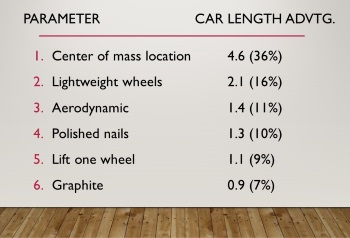At Hamilton, we know something about rolling resistance and wheels.
So let’s imagine you are the dad of a boy scout participating in a Pinewood Derby competition. Let’s also say you are an engineer with a particular ego problem – you can’t stand losing. Put aside for the moment the reality that your boy scout son will probably not be a part of winning the race.
The proven winning formula relies totally on physics. Transfer the maximum potential energy into the maximum kinetic energy, and voila’ – the trophy (monster-truck? No. but a trophy nonetheless).
Start with the maximum potential energy. The rules limit the overall weight, but don’t sacrifice even one microgram. The center of gravity must be near the rear of the car, which will increase the potential energy. Keep it about 1” in front of the rear axle, which tests have proven to be the ideal location.
During the race, when cars reach the bottom of the ramp and transition to the level portion, your car will still accelerate for a fraction of time that it’s center of gravity is still moving down, translating into increased speed. The competition will begin slowing since it exhausted the benefit of higher center of gravity earlier. This is the single biggest winning factor.
Next, if legal, trim the wheels on your car to make them narrow and lightweight. The lighter the wheels, the less rotational energy they will use which increases the available kinetic energy for speed. The potential energy at the start of the race turns into rotational energy of the wheels, speed, and friction losses. Minimize the rotational energy with lighter wheels.
 The top six parameters in rank order and their impact on the race by car length. Source
The top six parameters in rank order and their impact on the race by car length. SourceThird, reduce air friction by employing an aerodynamic shape. No wind tunnel required here – a basic pointy wedge works just fine.
Polish the axles to further reduce friction. Finesse this advantage by very slightly bending the axles and make the rear wheels ride on the inner edges. Set one front wheel so it’s not even on the track!
Finally, adjust the remaining front wheel to steer very slightly into the center rail of the racetrack, and ride on its outer edge. (This is called “railriding” for the true experts.) Finally, liberally apply graphite to the wheels and axles.
If this is still too much work, and you are in for the easy win, simply install a small canted CO2 cartridge in your basic pinewood derby block and use rocket propulsion to literally blow away the competition. But warning: this breaks the rules!
Learn more details and the source of much of this cool data here or checkout his 40 mph rocket propelled pinewood car.
If you can’t get enough, check out our white paper on Rolling Resistance and Industrial Wheels.